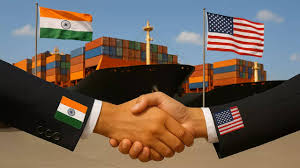By: Ijaz Yousafzai
In an unexpected turn of events, the bilateral trade relations between the US and India are most likely to receive a serious blow. This state of affairs is happening in the face of the fact that both New Delhi and Washington have once been intertwined with a common strategic inclination. In fact, both capitals have simply dreamed of common objectives, essentially aimed at countering powerful challengers like China and Russia. The United States, as a lame duck hegemon, has sought every possible option to preserve its current status in the world.
Somehow, this Washington arrangements took a sudden turn, typically soon after Trump’s return to the White House. He naturally thinks that to reassert Washington’s role in global affairs, there needs to be some kind of reset both domestically and globally. This pursuit of the so-called ‘reset’ turned into a global ‘deterioration’, leaving most of the states adversely effected, with only few able to survive. President Trump has already imposed a 25% tariff on India, and in an overnight social media post, he threatened New Delhi with much steeper tariffs.
“India is not only buying massive amounts of Russian Oil, they are then, for much of the Oil purchased, selling it on the Open Market for big profits. They don’t care how many people in Ukraine are being killed by the Russian War Machine…Because of this, I will be substantially raising the Tariff paid by India to the USA,” said Trump in the same social media post.
In response to the Trump’s latest tirade of threats, India has categorically called out E.U, and US and said that it was revealing that the very nations criticizing India were themselves indulging in trade with Russia. In a statement issued by the ministry of foreign ministry of India, it is said “Unlike India’s case, such trade is not even a vital national compulsion [for them]”.
“India has been targeted by the United States and the European Union for importing oil from Russia after the commencement of the Ukraine conflict. In fact, India began importing from Russia because traditional supplies were diverted to Europe after the outbreak of the conflict. The United States at that time actively encouraged such imports by India for strengthening global energy markets stability”, the statement reads.
The statement further says that Europe-Russia trade includes not just energy, but also fertilizers, mining products, chemicals, iron and steel, machinery and transport equipment. It adds that as far the United States is concerned, it continues to import from Russia uranium hexafluoride for its nuclear industry, palladium for its Electrical Vehicle industry, fertilizers as well as chemicals.
Mr. Lim Hui Jie, a market correspondent for CNBC, while referring to the European Commission data, said that the EU’s bilateral trade with Russia stood at 67.5 billion euros ($78.1 billion) in 2024, while its services trade in 2023 was at 17.2 billion euros, which was significantly higher than India’s total trade with Russia.
Donald Trump sees the BRICS nations as a potential threat to the dollar-based global hegemony of the USA, which is one of the reasons behind this tariff war. For how long will India withstand the US tariff war, is the basic question still remains unanswered. India’s diplomacy and its ability to access western capitals to sort out things is widely recognized. But Trump has drawn it to a position where it has to choose between bowing down to Washington or remaining uncompromised on its foreign policy principles.


